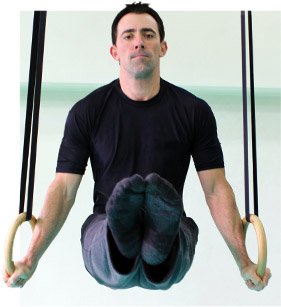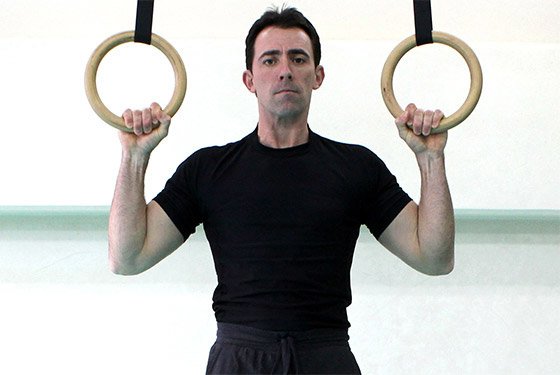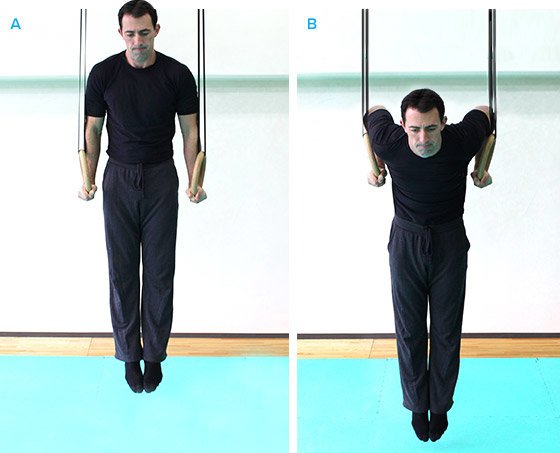Gymnastics rings are showing up in more gyms than ever before. However, many people mistakenly believe these wooden implements are only useful for athletes who use them in competition, like gymnasts or CrossFit athletes. In reality, anyone can use the rings and benefit from them tremendously, because they help simultaneously build strength, stability, and coordination like no other apparatus.
If you've ever watched the gymnastics events at the Olympics, you know how much strength the rings require. What you may not know about the rings, though, is how effectively they can be used to build incredible muscular size and definition. The rings may not be the first tool that comes to mind if hypertrophy is your goal, but as the incredible physiques of elite gymnasts show, ring work can help pack muscle on the upper body.
Are they easy? No, but nothing worth pursuing is. If you're willing to start at the bottom and master the techniques and routines I outline here, you'll find they're a great tool for building a muscular upper body that's every bit as strong as it looks.
Getting Off The Ground

The primary exercises that I'll show you are leverage holds and fundamental pulls and pushes that emphasize control over the rings and your body.
For now, you won't be doing any swinging moves on the rings. Instead, the primary exercises that I'll show you are leverage holds and fundamental pulls and pushes that emphasize control over the rings and your body. You'll soon realize that these are the best for hypertrophy and muscle conditioning anyway.
Most of these moves are classics with which you're familiar, but not like this. Why would you need to watch another tutorial on doing a pull-up, row, or dip? The answer: Because everything is different on the rings.
It makes perfect sense when you think about it. If you do a bodyweight pull-up on a stable object like a bar, the only moving object is your body. All you have to worry about is pulling your body to reach the bar.
With the rings, you can't rely on the stability of a bar; you have to stabilize the rings while also pulling your body up to meet them. This requires more control, tension, concentration, and effort.
You can't just jump on the rings and let your mind wander as you pump out the reps. This in itself is a major benefit to using them. As any experienced bodybuilder will attest, the mind-muscle connection is both real and highly effective at changing your physique, and it is front and center in ring training.
Right away, you'll notice improved muscular contraction and sensation, and even if you've been training for a while. This "new" style of training can also produce DOMS like you haven't felt since the first time you picked up a weight!
Where should I hang my rings?
One of the great advantages of rings is that they require little space. But not just any old spot will do!
- Don't just look around for something tall enough to hold your rings. Look for something strong enough to hold your bodyweight.
- Find a space where you can hang your rings 3-4 meters (10-13 feet) high.
- Set your rings about shoulder-width apart or a bit wider.
- Give yourself enough open space, in both height and width, to perform straight body movements.
- Make sure your straps are long enough to hang low so you can do push-ups, planks, mountain climbers, dips, and other movements.
- Kid's swing-sets can sometimes work, provided they're tall and stable enough. But some city parks have rules against adults unaccompanied by children. Don't risk a fine!
- Sturdy tree branches can work as well, provided they're really sturdy.
- There are endless ways to construct sturdy structures in your yard and home. Gold Medal Bodies has a handy resource with many proven ideas. Use it!
Gymnastics Rings Workouts
These two routines will help familiarize you with the unique challenges and stimulus offered by the rings, and they're great for building that coveted V-shape. If you can't manage all the reps at first, don't be surprised. Keep practicing until you can manage all the reps with good form and a full range of motion on pull-ups and dips before trying anything more advanced.

Keep practicing until you can manage all the reps with good form and a full range of motion on pull-ups and dips before trying anything more advanced.
Start with the fundamentals workout, and when you're feeling confident with it, mix in the superset workout.
Ring Fundamentals Workout
- Top position hold: 5 sets of 15 seconds, 30 sec. rest
- Ring dip: 5 sets of 8-12 reps, 1 min. rest
- Reverse row sit-back: 5 sets of 10-15 reps, 1 min. rest
- Tuck/L-sit: 5 sets of 15 seconds, 30 sec. rest
- Ring chin-up or pull-up: 5 sets of 8-12 reps, 1 min. rest
Dynamic/Isometric Superset workout
- Ring dip: 6-8 reps of dip, with a 15-sec. top position hold in between each rep. Do this for 5 sets with 1 min. rest between sets.
- Reverse row sit-back: 6 to 8 reps with a 15-sec. tuck/L-sit in between each rep. Do this for 5 sets with 1 minute of rest between sets.
- Ring chin-up or pull-up: 5 sets of 8 to 12 reps, with 1 minute of rest between sets.
Why These Exercises?
Exercise 1. Top Position Hold
Holding this position correctly will give you an intense triceps involvement, along with a contraction of the posterior deltoid and mid and lower trapezius. It's a great move to start your routine; it "wakes up" the upper body and core and prepares them for the work ahead.
Exercise 2. Ring Dip

Ring Dip
This classic bodyweight exercise is made exponentially harder by the unstable rings, so don't be alarmed if you can't do as many repetitions as you normally would on a fixed object. Again, be prepared for significant triceps contraction and pectoral involvement, especially if you pause for a second in the bottom position of the rep.
When fatigue hits, you'll notice the last few inches of the repetition seem impossible to complete. Keep pushing hard! This is where the benefit happens.
Exercise 3. Reverse Row Sit-Back
This unique combination move joins together a rowing movement with a pull-up and assists in that transitional strength between the two moves. It stimulates development in the lats, biceps, and shoulders.
It's not unusual to see a jump in performance on your regular rows and pull-ups after performing this exercise on the rings regularly for just a few weeks.
Exercise 4. Tuck/L-sit
This leverage hold takes abdominal training to the next level. Just as in the top position hold, your arms and shoulders will be working as hard as possible. But the added positioning of having your knees or entire leg lifted up makes it even more difficult.
Be prepared to hold for less time and do more sets in the beginning to get used to doing these moves on the rings.
Exercise 5. Ring chin-up or Pull-up
The lats, rhomboids, deltoids, biceps, abdominals, forearms, and even the pecs get worked hard in the ring version of the mighty pull-up. The moving rings make it more difficult, but they can also be a lifesaver for people who experience elbow or shoulder problems when doing pull-ups on a straight bar.
The free rotation of the rings lets you change your positioning in a way that you can't on a fixed bar, and this often helps alleviate the strain that may be giving you problems.
Practice, Practice, Practice
There is one important thing to keep in mind if you're looking to incorporate rings into your training regimen: They require patience and dedication. One of the most common things we hear from our clients is how humbling they found ring training to be initially. You may be strong, but you'll be required to use your body in a different way than you're used to.
I recommend choosing one of the routines described above and sticking with it for at least 4-6 weeks exclusively. This will give you the chance to get acclimated with this new training style. Don't worry about losing ground in your other upper body lifts; if anything, you might find they're stronger when you go back to them.
After you feel a bit more comfortable using the rings, incorporate rings exercises into your regular training as you see fit.

